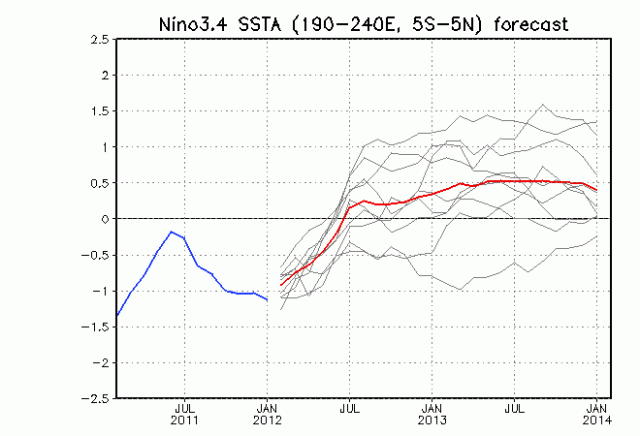Bastardi-The La Nina and Why I Believe It's Over 13 years ago
March 5 08:21 PM
Last year I was loudly proclaming that idea that the La Nina was done were wrong. When NOAA declared it over, both Joe D'Aleo and I went after them, with Joe showing the cold PDO averaged La Ninas that were 21 months and El Ninos less than a year. I felt rather strongly that there is an undercurrent of lack of understanding of why there are these bounces back and forth in many of the official sources and part of it has to do with an agenda that has infilltrated many government weather services worldwide, including the idea that somhow a trace gas that comprises less than .04% of the atmosphere, and even less of the ocean, as going to control the climate. The more I dig into this, the more amazed I am at how this has gotten this way. But the cry of permanent El Ninos and tipping points are something that is being looked for (and hoped for) as much as a kid wishing for Santa at Christmas. BTW, I believe more in Santa than CO2 warming the planet.
But we have had a 2 year La Nina and 4 out of the last 5 years. This is part of the turn of the PDO to cold and a cold PDO invites La Ninas. The stronger the combination of La Nina and cold PDO run up, the warmer the eastern winter has been. The coldest eastern winters are during cold PDOs and La Ninas that evolve into El Ninos with a warm PDO spike.
The worst thing that could happen for next year, and winter weather lovers, is the la nina and cold PDO again. This is not likely to happen. It is more likely to happen at the end of the cold PDO and that is over 2 decades away. But why would I say that...wishcasting??? No it's not that, though I do think there is some wishcasting going on my side of the global warming debate as I recently challenged the assertion the La Nina would continue. This is not likely because of certain physical realites.
One of them is Le Chatelier's principle applied to the climate. The turn to colder now globally, which is being spurned on by the colder PDO, is partly because the earth is constantly trying to find a set point for its temperature, and because there is no net change in the energy budget of the earth, rises and falls have to occur. They occur decadoly and yearly. The drop that has occurred will force a response. Since the earth had gone through 20 some odd years of a warming signal, there is a pre-existing warm signal that is a bakdrop. A sudden turn to colder means that there will be a response back the other way to respond. In times of warming, the warming outstrips the cold, and now it's the other way. But there is a response to the colder, that will take place.
I have major model support across the board.
The JMA

ECMWF
.gif)
ECMWF multi-model
.gif)
CFSv2:
.gif)
CFS:
.gif) \\\\\
\\\\\
There is another reason: The sun. The incoming solar radiation being low will invite El Ninos. How so? The weaker the sun, the more the easterlies are reduced. In fact, volcanoes in the tropics spewing ash are notorious for helping the development of El Ninos. This is something different from previous cold PDO cycles. Interestingly enough, if the backdrop signal of the cold PDO with a low sun would allow for ninos trying to come on and perhaps spiking the PDO, and perhaps enhance that winter signal that snow and cold lovers dream about (cold PDO and La Nina flipping to an El Nino, but a stronger warmer PDO spike in relation to the nino.. see the winter forecast.
In any case, it's not likely that this is a 3 year nina. Last year, we felt strongly about the la nina coming back, this year I think there is plenty of reason to think the opposite.
With the El Nino coming on, a Hansen super nino watch remains in effect
Thanks for reading, ciao for now.